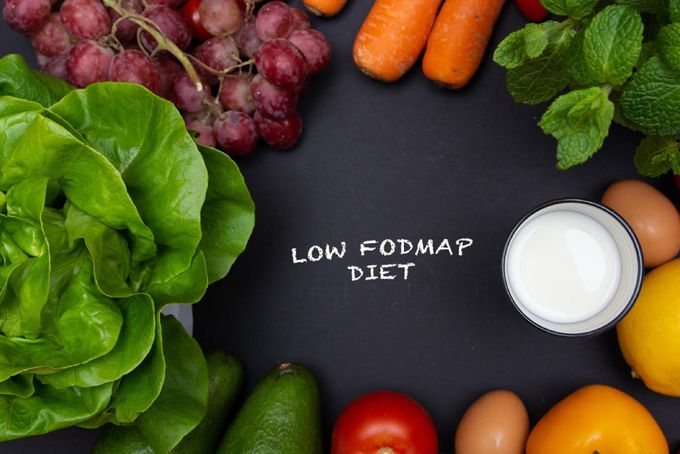Unraveling FODMAPs: A Guide to Children's Digestive Health
Updated October 2, 2024

In the vast world of nutrition, the term "FODMAP" may seem like just another buzzword. However, for parents striving to ensure the best dietary choices for their children, understanding FODMAPs is crucial. With a direct impact on digestive health, FODMAPs can play a silent yet significant role in your child's well-being. Recent studies, including those published in renowned journals like the 'American Journal of Gastroenterology,' have underscored the significance of FODMAPs in relation to gastrointestinal symptoms, especially in children. From the tiniest infant to the most active toddler and beyond, the foods we introduce to our little ones can either support their growing bodies or lead to discomfort. This article delves deep into the world of FODMAPs, highlighting their relevance to children's diets and offering guidance to parents navigating these often confusing waters. Whether you're a new parent or have been on this journey for years, this guide aims to equip you with knowledge and actionable steps to make informed dietary choices for your child.
What are FODMAPs?
FODMAP is an acronym that stands for Fermentable Oligosaccharides, Disaccharides, Monosaccharides, and Polyols. These are specific types of carbohydrates found naturally in various foods, from fruits and vegetables to dairy and wheat. Some people have difficulty digesting these compounds, leading to potential gastrointestinal issues such as gas, bloating, stomach pain, and even irritable bowel syndrome (IBS).
For children whose digestive systems are still developing, the intake of high-FODMAP foods can be particularly impactful. For instance, lactose, a well-known disaccharide, is found in milk and discomfort can occur when an individual has low levels of the digestive enzyme lactase in their GI tract. Another example is fructans, a type of oligosaccharide present in foods like wheat, garlic, and onions.
Recognizing which foods are high in FODMAPs and understanding their potential effects can be a significant step for parents keen on ensuring optimal nutrition and digestive health for their kids.
Why FODMAPs Matter for Kids' Health
Children are in a constant state of growth and development, and their digestive systems are no exception. As these systems mature, they can sometimes be sensitive to certain foods, and FODMAPs often top the list. High-FODMAP foods can lead to gastrointestinal distress in some children, which can manifest as gas, bloating, diarrhea, or even constipation. Beyond the immediate discomfort, recurrent digestive issues can affect a child's appetite, growth, and overall well-being.
Furthermore, prolonged digestive discomfort can impact a child's mood, sleep patterns, and even their academic and social life. Understanding the influence of FODMAPs is not about demonizing certain foods but rather equipping parents with the knowledge to make informed choices. For children with digestive problems, parents should talk to their healthcare professional about the potential need to monitor or adjust these types of carbohydrates in their child's diet.
Identifying High and Low FODMAP Foods
Navigating the world of FODMAPs can initially seem overwhelming, especially when trying to tailor a child's diet. But with a bit of guidance, it becomes simpler. High-FODMAP foods, which might be more challenging for some children to digest, include items such as apples, milk, garlic, beans, and certain sweeteners like honey.
On the other hand, plenty of low-FODMAP options are easier on the digestive system. Think of foods like carrots, grapes, lactose-free dairy products, spinach, and oats. It's important to note that many high-FODMAP foods are nutritious and don't need to be eliminated entirely unless they cause noticeable discomfort.
Instead, they can be reduced or substituted as needed. For parents keen on maintaining a balanced diet for their children, recognizing these food categories and being flexible in meal planning can be the key. Over time, as children grow and their digestive systems develop further, their tolerance to certain foods might also change, necessitating periodic reviews of their dietary choices.
Things to Consider Before Starting
Before embarking on a low-FODMAP diet for your child, consider many considerations to ensure a good and effective experience. First and foremost, always consult with a pediatric nutritionist or gastroenterologist before making any major dietary decisions, as they can provide personalized advice for your child's specific needs.
Remember that a low-FODMAP diet is normally used as a short-term measure to identify triggers and many foods can be gradually reintroduced after this period. Given the diet's limited nature, be aware of potential nutrient shortages and consider a diversified intake, as well as fortified foods or supplements, as indicated by health professionals.
Because children's digestive systems are constantly developing, their dietary tolerances can alter; a current trigger may become tolerable later on, or vice versa. Consider the emotional and social consequences of such a diet as well. When children are unable to enjoy meals with their peers, they may feel alone, so finding methods to include them — such as creating special FODMAP-friendly sweets for occasions — is critical.
Finally, raise awareness: ensure that everyone in your child's life, from educators to relatives, is aware of their dietary needs in order to avoid unintentional consumption of triggering foods. Taking these measures will result in a smoother and more fruitful transition into this dietary adventure.
Implementing a Low-FODMAP Diet for Children
Before making any significant changes to your child's diet, consultation with a nutritionist or pediatrician is crucial. It is recommended that low-FODMAP diets for young children only be implemented under supervision of a healthcare professional in order to ensure they are still receiving adequate nutrition for growth. If you've observed signs of digestive discomfort in your child and suspect high-FODMAP foods might be the culprit, consider the following steps:
- Seek Professional Guidance: Discuss your concerns about your child's digestive health with your pediatrician and request a referral to a healthcare professional experienced with elimination and FODMAP diets, such as a pediatric registered dietitian-nutritionist or a pediatric gastroenterologist. Their expertise will provide guidance to prevent nutrient deficiencies, as well as offer personalized recommendations and peace of mind.
- Start with a Food Diary: Before making any changes, jot down everything your child eats for a week. This will give you a clear picture of their current intake and help identify potential high-FODMAP foods they consume regularly.
- Gradual Transition: Consider gradually reducing high-FODMAP foods from your child's diet instead of an abrupt switch. This approach can help identify specific triggers and minimize potential nutritional gaps.
- Focus on Variety: While certain foods might be eliminated or reduced, ensure your child still gets a diverse range of nutrients. Incorporate a variety of low-FODMAP vegetables, fruits, grains, and proteins to maintain a balanced diet. Most importantly, continue a food diary during this phase and continue to regularly follow-up with your supervising healthcare professional.
- Reintroduction Phase: After a period on a low-FODMAP diet, reintroduce foods one by one. This process helps pinpoint specific foods that might be causing discomfort, allowing for a more personalized and flexible diet in the future.
Remember, a low-FODMAP diet isn't about restricting your child but rather about offering them comfort and optimal health. Patience and the right resources can be a transformative journey for parents and their little ones.
Potential Challenges and Solutions
While the merits of a low-FODMAP diet for children experiencing digestive issues are evident, implementing such a diet isn't without its challenges. Here are some common hurdles parents might encounter and solutions to address them:
Limited Food Choices
Parents might feel their options are limited with several foods categorized as high in FODMAPs.
- Solution: Dive into international cuisines! Many global dishes use low-FODMAP ingredients. Exploring these can diversify the menu and make meals exciting.
Social Events
Birthday parties, school events, and outings can pose a challenge when most available foods are high in FODMAPs.
- Solution: Equip your child with low-FODMAP snacks or meals before attending events. Communication is also key: Inform teachers and other parents about your child's dietary needs to ensure they have suitable options.
Understanding Food Labels
Packaged foods can be tricky to navigate as they might contain high-FODMAP ingredients not immediately recognizable.
- Solution: Educate yourself on common additives or ingredients derived from high-FODMAP foods. Apps dedicated to the FODMAP diet can also be handy for quick checks while shopping.
Ensuring Nutritional Balance
The risk of omitting essential nutrients while avoiding high-FODMAP foods is real.
- Solution: Rotate foods within the low-FODMAP spectrum to ensure a varied intake. Regular consultations with a dietitian can also help track and maintain nutritional balance.
Feelings of Exclusion
Children on a restricted diet might sometimes feel left out or different from their peers.
- Solution: Open communication is essential. Educate your child about their dietary needs in an age-appropriate manner, ensuring they understand it's about their well-being. Organize low-FODMAP-friendly events or playdates to make them feel included.
Recognizing and preparing for these challenges ensures that the dietary transition is smooth and stress-free for both parents and children.
Benefits Beyond Digestion
While the primary purpose of the FODMAP diet is to relieve digestive discomfort, its benefits extend beyond the gut. Adopting a low-FODMAP diet for children may have some unanticipated benefits:
- Digestive discomfort can frequently interfere with a child's sleep. Many parents report improved sleep habits in their children after addressing the main source of their pain.
- A healthy stomach has the ability to influence the brain via the gut-brain axis. Children who are not plagued by chronic stomach problems may demonstrate a more positive mood and better overall behavior.
- Proper digestion and absorption can result in increased energy levels, allowing children to be more active, alert, and interested in their everyday activities.
- By focusing on a diet that is easy on the digestive system, the body may absorb nutrients more efficiently, resulting in improved overall health.
- The gut plays an important role in immunity. A healthy digestive tract may boost a child's immune response, making them less susceptible to common infections.
- While many people may reap these additional benefits, others may not. The primary goal remains to alleviate stomach discomfort. However, these additional potential benefits make parents' efforts to adapt to a low-FODMAP diet even more valuable.
Tips for Making the Transition Easier
Moving to a low-FODMAP diet can feel daunting, especially for children who are particular about their food choices. However, this transition can be smooth and even enjoyable with the right approach. Here are some tips to ease into this new dietary regimen:
- Educational and Fun Activities: Use educational games or apps that teach children about FODMAPs in a fun, interactive way. This way, they become familiar with what they can and cannot eat.
- Involve them in Meal Planning: Let your child be part of the decision-making process. When they have a say in their eating, they’re more likely to be enthusiastic about it.
- Experiment with Recipes: There are countless delicious low-FODMAP recipes available. Try new dishes regularly to keep meals interesting and appetizing.
- Plan Ahead: If you know you’ll be out for the day, pack low-FODMAP snacks or meals. This way, you're not caught off guard when hunger strikes.
- Stay Positive: Children pick up on parental vibes. If you’re stressed about the diet, they will be too. Approach the transition with a positive mindset and reinforce the benefits to them.
- Seek Support: Join parent groups or forums where you can share experiences, seek advice, and get recommendations related to the low-FODMAP diet.
Remember, this is a journey for both you and your child. Taking it one step at a time, celebrating small victories, and constantly learning can make the transition not just bearable but beneficial and gratifying.
Conclusion
The world of FODMAPs opens the door to a better understanding of our children's digestive health. While it might seem challenging at first, gaining this knowledge is a step towards ensuring their overall well-being. Parents are the first line of defense in spotting and addressing potential sensitivities, making it crucial to stay informed and patient.
Remember, every child is an individual; what works for one might not work for another. With time, observation, and a little guidance, you can navigate the FODMAP landscape, ensuring your little ones thrive and enjoy a broad, nutritious diet tailored to their needs. Stay empowered, stay informed, and above all, trust the journey.
The content and advice provided in this article are for informational purposes only and are not a substitute for medical diagnosis, treatment, or advice for specific medical conditions. Always consult a pediatrician to understand the individual needs of your child.










